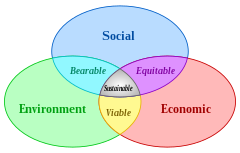 |
| A Venn Diagram that intersects social sustainability with environmental and economic sustainability. A situation can be viable, but if it is not bearable or equitable it cannot be sustainable. |
According to Social Life, a UK-based enterprise specializing in place-based innovation, social sustainability is "a process for creating sustainable, successful places that promote well-being, by understanding what people need from the places they live and work. Social sustainability combines design of the physical realm with design of the social world – infrastructure to support social and cultural life, social amenities, and systems for citizen engagement and space for people and places to evolve."
Social sustainability has many aspects to it, and you can read more about it at the United Nations Global Impact. Since our tips focus on small changes we can do today, I decided to focus on the one that might be the one the most immediately within our control. Namely, the idea that a workplace is not sustainable without employee retention; and workplaces lose money in production and staffing every year due to staff burnout; and it’s important with everything going on that we are sure to make our workplaces as socially sustainable as possible. I was in fact so happy to learn about this whole concept, because it rectifies the problems I have with the term "self care"-- while I was on board for awhile, "self care" has seemed to become this catch-all of workplace happiness and quite frankly, I've begun to think about it as a way that toxic workplaces can blame employees for their own low morale or other reactions to systemic workplace toxicity. This article helped to validate those feelings when I thought it was just me. I like viewing workplace culture through the social sustainability lens because it seeks to work on the workplace as well as the individual. It's about how we can make small changes to improve our workplace, not just about how we can steel ourselves against workplace toxicity as if it is an unexplained phenomenon that cannot be helped.
Stressful situations can flip your lid, and I know regular readers are familiar with this term but here is a video that explains it (it talks about kids, but we all need it!) Here are some things that have worked for me to stay engaged when it's tough:
